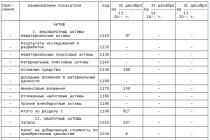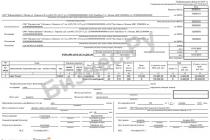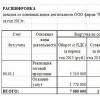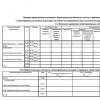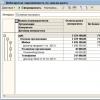The balance sheet is considered the main component of financial statements, and it displays all the economic activities of the enterprise for a certain time period. Thanks to a well-written document, you can determine whether the company's work was successful.
At its core, the balance sheet is the main form of reporting. The document consists of several summary tables that contain information regarding the company's cash assets, debt obligations and total profits. It should be noted that the balance is drawn up for a certain period of time, and carries only the information that corresponds to a given period.
The balance has a prescribed form, and therefore it must be filled out with an eye to the legislative requirements for this type of documentation. In the event that the document is drawn up incorrectly and there are errors in it, it may adversely affect the activities of the business entity as a whole.
General points
The balance sheet is an official financial document that contains data on the activities of the production structure for a specified time period. This document is mandatory, and it must be registered with the Federal Tax Service. As a rule, most often the balance analyzes data on the enterprise for the calendar year, although it is allowed to draw up interim documentation for reporting periods.
The form of the balance sheet is approved at the highest legislative level, and the document consists of two subsections: assets and liabilities. The first displays all the property that is owned and used by the company, distributed by structure and location. But the second section classifies the available resources according to the data on their sources.
It is worth noting that for Russian companies, the balance sheet is a mandatory document, and it must be submitted to the authorized bodies to check the effectiveness of the structure. If the document was not submitted to the Federal Tax Service, then the company's activities may be suspended.
The balance sheet, with the help of which the enterprise reports to the state on the work done, is compiled in form 1 or 0710001 (legally approved name of the document). Considering that the activities of various companies can be classified according to many parameters, it is allowed to use both the full and the simple form of the document.
It is quite natural that most entrepreneurs tend to act according to a more simplified scheme, and for this they use a simplified reporting form.
However, in accordance with legal requirements, this opportunity is provided only for those legal entities that meet the following criteria:
- the share of the authorized capital, which is under the control of the legal entity, does not exceed 25%;
- the number of hired employees does not exceed 100 people;
- the total revenue of the enterprise is within 400 thousand rubles, and does not exceed this indicator.
For all other cases, you will have to complete the reporting on Form 1 in full. Otherwise, it will be perceived as a violation of the current legal framework, and the violator will be punished in accordance with the law.
Existing species
In accordance with the requirements of the Federal Law No. 402 of 01/01/2013, the financial statements must cover all data regarding the financial position of the analyzed business entity.
And in order to achieve the task, the basis for the preparation of the balance sheet will serve, and the following reporting must be included in the final document:
- annual data on the work of the company;
- annual reporting for organizations whose task does not include maximizing profits (non-profit structures);
- interim reporting, which is compiled for a certain period of time (3, 6 months, etc.);
- internal reporting.
If we talk about the documentation, which will collectively constitute reporting, then it can be described as follows:
In turn, in addition to the traditional balance sheet, the following types of reporting documentation are distinguished:
| Balance of income and expenses | Shows the amount of cash receipts in the organization and the amount that was spent for various purposes. |
| Gross and net balance | In the first case, the document is used to improve information functions, but in the second case, it allows you to determine the real value of all company assets. |
| Opening balance | Compiled at the beginning of the company. It displays all the resources with which the organization begins to carry out its activities. |
| Final | Contains data for a previously designated period of time. |
| Liquidation balance | Assesses the financial position of the enterprise, which will soon cease to exist. |
| Working balance | The movement of funds within the company is analyzed. |
| preliminary document | Compiled based on current performance indicators. It shows what results of activities can be achieved at the end of the reporting period while maintaining current operating conditions. |
| Interim balance | Prepared before the end of the financial year. |
| Balance document | The property values of the company and the sources of their formation are characterized. |
| Consolidated | It is obtained by combining indicators for several business entities. Most often this is used by state bodies of control and statistics. |
The main design details
The necessary conditions
Any enterprise that sets itself the goal of obtaining the highest possible profit uses the balance sheet as an integral part of the workflow. In accordance with the established legal requirements, this form of reporting is mandatory for all structures whose work is aimed at making a profit.
Financial statements are formed through careful analysis and control of all processes that take place in the company. In view of this, in addition to the balance sheet, it should also include other documents relating to the use of cash, the expenditure of tangible and intangible resources and the movement of capital.
In 2013, a resolution approved by the Russian Ministry of Finance was adopted, according to which all business entities were required to submit accounting documentation for control by authorized state structures. At the same time, it is separately indicated that those organizations that are classified as "small" businesses can submit reports in a different form, which is known as simplified.
If at the time the resolution was approved, the enterprise used the simplified tax system, and until 2014 did not have time to report in a given form, then in this case the legislator requires to restore and confirm all financial documents for the past few years.
After the adoption of Federal Law No. 402, reporting is submitted once per calendar year, and an explanatory note to the document is not required. After the financial year, the company must submit the completed balance sheet to the tax service within 3 months. If the deadline is not met, financial measures will be taken against the company.
Formation of a liquidation account
In the event that the activity of the enterprise was recognized as unsatisfactory, and its owners made a unanimous decision to stop work, then you need to know that this process is under the full control of the state. In view of this, the liquidation should take place taking into account the requirements specified in Federal Law No. 129 and Art. 61-64 of the Civil Code of the Russian Federation.
Based on the basic rule, upon completion of settlement transactions with creditors, the liquidation commission responsible for the termination of the company's activities must form a liquidation balance sheet, which will display all data on the company's work at the time of its closure.
This document is approved either by the body that initiated the liquidation, or by members of the founding board of the company. However, it is worth paying attention to the fact that there is no special form for this report, and therefore it is rational to use the form that is standard for the annual balance sheet.
The liquidation account has some features, in particular:
- The liquidation balance sheet is automatically recognized as inventory, which means that its formation takes place based on the results of the inventory and taking into account the requirements of Art. 12 FZ No. 129.
- The balance cannot contain leftovers, so everything possible must be done to get rid of them as soon as possible.
- When drawing up a liquidation account, the value of the property is established, which will allow us to conclude what became the main reason for the liquidation. So the valuation of the company's assets in the liquidation balance sheet will be completely different from the standard reporting.

Relationship with other documents
Absolutely all forms of financial statements have close relationships with each other. When compiling and filling out the balance sheet, it is imperative to take into account all the data on the reporting forms to determine the same results.
Thus, all indicators that one way or another play a key role in the accounting of an enterprise should be grouped according to appropriate forms. In addition, each of them will have an independent purpose, but at the same time refer to other reports.
Often, the nature of the relationship between the forms of reporting documentation is determined as logical and informational. In this case, the logical connection will be due to the fact that the double-entry rule is used when compiling the documentation. This means that the same data will be duplicated in several reports at once.
If we analyze the relationship characteristic of the balance sheet, then it will have the following structure:
In addition to the fact that close links are available for the main forms of reporting, relationships will also be established between individual balance sheet items. This will be expressed in the fact that some lines of the document will be defined as adding or subtracting other lines.
Sample of filling in the balance sheet:


An example of filling out a balance sheet form
The approved form of the balance sheet in 2017 must be completed in such a way as to comply with all the requirements of the legislative framework. And this operation begins with filling in the required details. After that, you can proceed to display all the necessary indicators for the financial activities of an economic entity.
With all this, it is important to pay attention to the basic rules:
- Data at the beginning of the reporting period should be displayed in the document and correspond to the information that was available at the end of the previous period.
- The results for the subsections "asset" and "liability" should be completely identical.
- All information must be presented in expanded form. Offsetting between balance sheet items is not allowed in any case.
- All data presented in the balance sheet must have appropriate documentary evidence.
The reporting document will consist of many separate lines, the main of which will be:
At the end of the document, a total is summed up, which should be equal for all subsections. This means that the total value of assets and liabilities must be identical and not differ.
In order to better understand how the document is filled out, you need to download the form for free on specialized Internet sites dedicated to accounting issues and study the Word filling sample (Word).
Other requirements
With regard to the rules for compiling the balance sheet, the legislator puts forward rather stringent requirements, which must be taken into account and displayed in the final document without fail.
In particular, the document must have some details:
- classifier OKUD and type of activity of the company according to;
- the exact date on which the report was drawn up (as a rule, this is the first day of the coming month or the last day of the current one);
- data on the organization, namely the full name of the structure, TIN, organizational form, form of ownership, exact location (it is important that all the data provided correspond to the information specified in the constituent documentation);
- the date of acceptance and approval of the document, as well as a mark on the date the balance was sent for registration with the tax service;
- a specific unit of measurement (thousand or million rubles).
In no case should you leave empty lines in the balance sheet. If any values are missing in the document, a dash must be entered. A similar solution is used for situations where, due to rounding, the total sum of some rows is zero. If the value of the string is negative, then this indicator should be framed in parentheses.
In general, all the rules and requirements for filling out the balance sheet are quite clearly and spatially described in the relevant legislative acts and regulations. And it is extremely important that each of the approved rules be taken into account. Otherwise, you may encounter a problem when the balance sheet will not be registered with the tax service due to incorrect compilation or existing errors.



